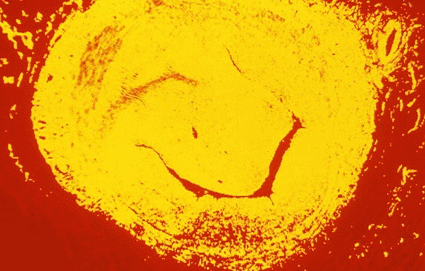Altepase Treatment Clears Deep Vein Clots
By HospiMedica staff writers
Posted on 13 Feb 2008
Posted on 13 Feb 2008

Image: Digitized light micrograph of a cross section of a blocked vein: a condition known as deep vein thrombosis (DVT) (Photo courtesy of CMSP / SPL).
DVT commonly affects the leg veins, such as the femoral vein or the popliteal vein or the deep veins of the pelvis. Occasionally the veins of the arm are affected (known as Paget-Schrötter disease). Thrombophlebitis is the more general class of pathologies of this kind. There is a significant risk of the thrombus embolizing and traveling to the lungs causing a pulmonary embolism.
Investigators at the [U. S.] National Institutes of Health (Bethesda, MD, USA) sought a treatment regimen that would allow direct clearance of the clot without requiring continuous infusion of a thrombolytic agent. They chose to work with the drug alteplase (tissue plasminogen activator [TPA]), an enzyme that occurs naturally in humans and causes blood clots to dissolve. In its pharmaceutical form, it is manufactured by recombinant DNA technology. Alteplase possesses such high affinity for fibrin that it was not necessary to continuously infuse this thrombolytic agent.
In the current study, 20 patients (13 men and seven women aged 18-79 years) with first-onset acute DVT were treated with direct intraclot lacing of the clot with alteplase (maximum daily dose, 50 mg per leg per day; maximum of four treatments) and full systemic anticoagulation. Ventilation-perfusion (V/Q) scans were performed for evaluation of embolic risks, and clinical and imaging examinations were supplemented with pharmacokinetic studies to enable further assessment of treatment outcomes.
Results published in the February 2008 issue of the journal Radiology revealed that blood flow was restored throughout the deep venous system in 16 patients (80%) during thrombolytic therapy, with complete resolution of symptoms in 18 patients (90%) after six months of anticoagulation. Pharmacokinetic studies showed rapid clearance of circulating alteplase and recovery of plasminogen activator inhibitor-1 levels within two hours after termination of alteplase treatment.
V/Q scans revealed a 40% incidence of pulmonary embolism before treatment and a 15% incidence of asymptomatic pulmonary embolism during thrombolytic therapy. There were no cases of clinically important pulmonary embolism or serious bleeding during thrombolytic therapy. During a mean follow-up period of 3.4 years, no patient developed a post-thrombotic syndrome or recurrent thromboembolism.
"This treatment regimen is able to clear blood clots rapidly and safely, restoring blood flow in the veins of the lower leg, and the results are durable,” said first author Dr. Richard Chang, chief of the interventional radiology section of the department of radiology at NIH.
Related Links:
[U. S.] National Institutes of Health














